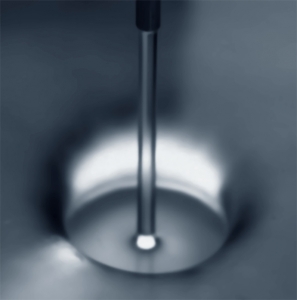The to-and-fro of a liquid wall
The impact of a vertical jet of water on a horizontal surface is something we experience as soon as we turn on the kitchen tap. At the bottom of the sink, we can observe a more or less circular liquid wall separating two distinct zones: a thin inner zone and a thicker outer zone. This liquid wall, known as the circular hydraulic jump, has intrigued people since Leonardo da Vinci, and remains a subject of current interest and study. In a recent article, we highlighted a new aspect of this constriction: under certain conditions, it can start to oscillate spontaneously, opening and closing periodically, while the jet is stationary.
For centuries, « natura non facit saltus » (nature doesn’t make jumps) has been a guiding principle in philosophy and physics. We know today that this principle is not always valid, but it’s always interesting to observe and understand cases where it doesn’t apply. In particular, we don’t expect fluids to be systems where we find discontinuous jumps, but in reality we find among free-surface flows magnificent phenomena that seemingly violate the natural principle of continuity.
Hydraulic jumps are an edifying example of this, which is why so much work has been devoted to understanding them over the centuries. Despite these efforts, there is still no simple, consensual model that can fully describe hydraulic jumping. However, all theories and experiments to date agree that the circular jump is a stationary object.
We have recently shown that this is not always the case. Indeed, if a sub-millimetre jet of water is allowed to impact the center of a Plexiglas disc, spontaneous oscillations of the jump can be observed.
This dynamic can be explained by the emission of gravity waves by the jump, which reflect off the edge of the disc, forming a « resonance cavity » (in the same way that sound resonates in the body of a guitar). The resonance cavity selects a frequency for these gravity waves, which, due to variations in height, will periodically close and open the jump. This coupling can even be used to synchronize distant springs that oscillate in phase opposition if they are placed where variations in water height are greatest.
This new phenomenon opens up new perspectives for the transient study of jet impact and its interaction with gravity waves, but also, by analogy, to other fields ranging from acoustic shock waves (wall of sound) to astrophysics, where it is used as an analogue for white holes.
However, our research is not just fundamental: jet impact also plays a fundamental role in surface cooling and cleaning processes. Oscillations of the jet are likely to modify the thermal and mechanical transfers involved, and thus have a real impact on the efficiency of these processes.
Contact :
Full details of the study can be found at: https://journals.aps.org/prl/abstract/10.1103/PhysRevLett.131.194001
This work was announced in Le Monde
https://www.lemonde.fr/sciences/article/2023/11/29/physique-quand-l-eau-joue-a-cache-cache_6202968_1650684.html
and in Physics
https://physics.aps.org/articles/v16/s151
















